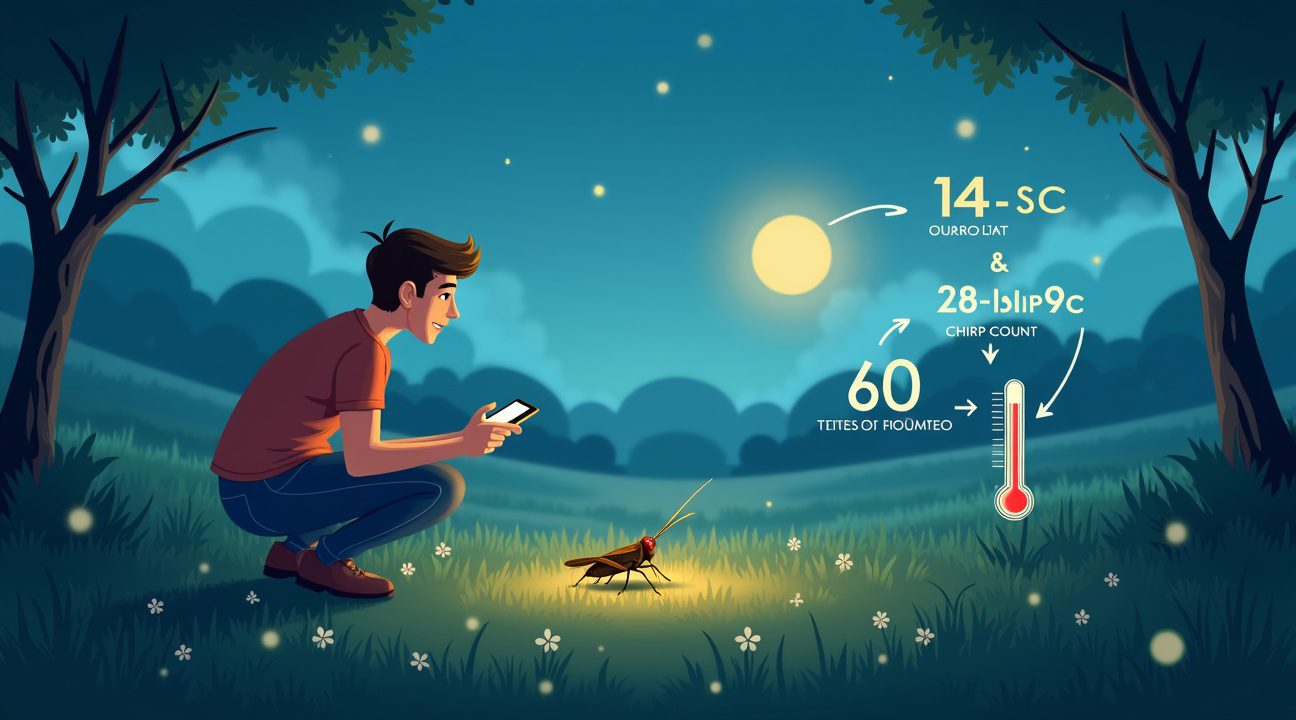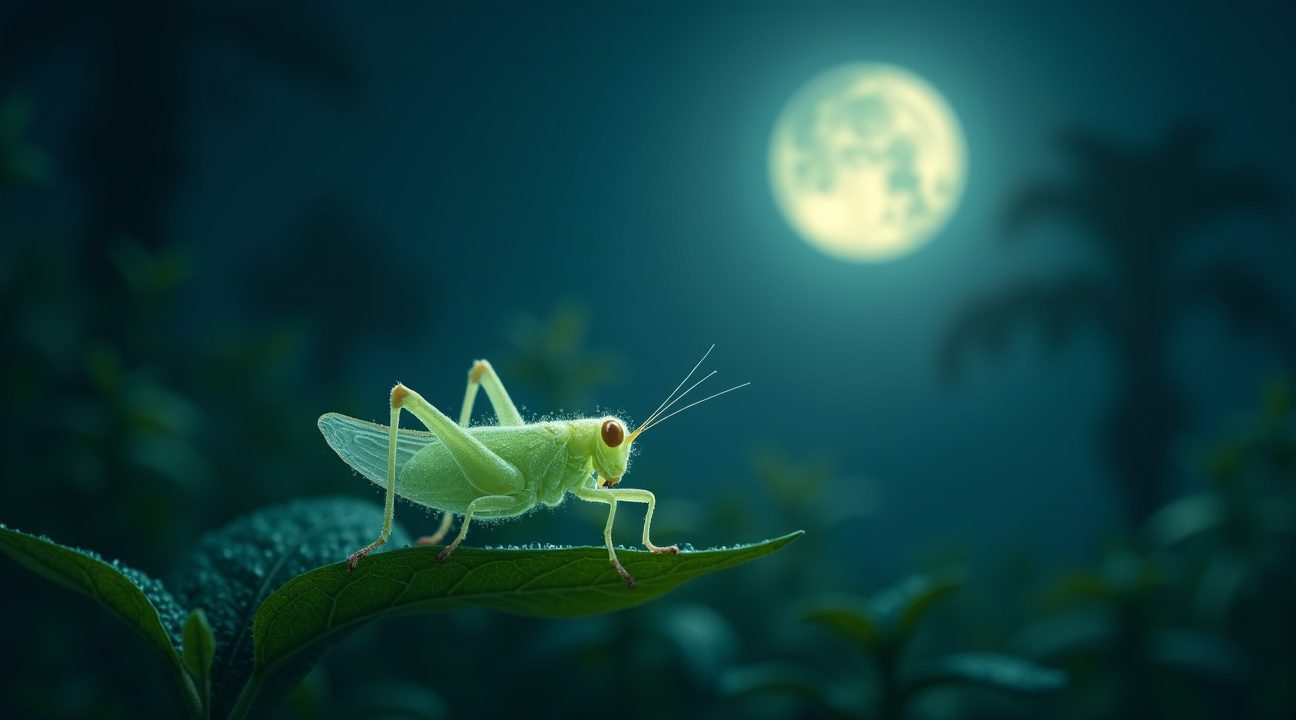Crickets serve as remarkably accurate natural thermometers through a scientific principle known as Dolbear’s Law, which establishes a mathematical relationship between cricket chirp rates and ambient temperature. This phenomenon occurs because crickets are cold-blooded insects whose metabolic processes and muscle contractions speed up proportionally with rising temperatures, creating a reliable biological measurement system that scientists have validated for over a century.
Key Takeaways
- Simple temperature formulas work reliably – Count cricket chirps for 14 seconds and add 40 for Fahrenheit, or count for 8 seconds and add 5 for Celsius. These formulas typically maintain an accuracy within 1-2 degrees.
- Snowy tree crickets provide the most accurate readings – Known as “thermometer crickets,” this specific species maintains the most consistent temperature-to-chirp relationship compared to field crickets or other varieties.
- Temperature range limitations affect accuracy – Cricket thermometry works best between 55°F to 100°F (13°C to 38°C), as crickets become inactive or stressed outside this range.
- Environmental factors can interfere with measurements – Wind, background noise, humidity, competing males, and the cricket’s age or health status can all impact chirping patterns and reduce accuracy.
- Dolbear’s Law has practical modern applications – Emergency responders, hikers, and educators use this method as a backup temperature measurement tool, while the National Weather Service offers online cricket chirp converters for citizen scientists.
Count Cricket Chirps to Get the Temperature: Simple Formulas That Actually Work
Cricket chirp equations provide remarkably accurate temperature readings when applied correctly. I find these formulas work best during calm evenings when cricket activity remains consistent and environmental factors don’t interfere with their natural behavior patterns.
Quick Temperature Calculations Using Cricket Chirps
The most popular cricket chirp equation requires counting chirps over 14 seconds, then adding 40 to estimate temperature in Fahrenheit. When I count 30 chirps in 14 seconds and add 40, I get an estimated temperature of 70°F. This Dolbear’s Law formula works reliably for most common temperature ranges encountered during cricket season.
Several alternative methods provide flexibility depending on your counting preferences:
- Temperature (°F) = 50 + [(number of chirps in 60 seconds − 40) / 4] offers precision for longer observation periods
- Temperature (°C) = (number of chirps in 60 seconds + 30) / 7 converts directly to Celsius measurements
- Temperature (°C) = Number of chirps in 8 seconds + 5 serves as the fastest shortcut method
The 8-second shortcut proves especially useful for quick ambient temperature estimation. I simply count cricket chirps for 8 seconds, add 5, and obtain the temperature in Celsius immediately. This method eliminates complex calculations while maintaining reasonable accuracy.
These formulas demonstrate highest precision between 5°C and 30°C, covering most comfortable outdoor temperatures when people typically notice cricket activity. Outside this range, cricket behavior becomes less predictable, and weather sensing abilities might prove more reliable than insect-based measurements.
Cricket temperature measurement works because these insects are cold-blooded creatures whose metabolic rates directly correlate with ambient temperature. Warmer conditions accelerate their chirping frequency, while cooler temperatures slow their vocal activity. This biological response creates a consistent relationship between chirp rate and environmental temperature.
I recommend choosing one formula and practicing with it consistently rather than switching between methods. The 14-second count plus 40 formula offers the best balance of simplicity and accuracy for most users. During outdoor activities, this natural thermometer provides instant temperature readings without requiring any equipment beyond basic counting skills.
Much like how natural cycles help us track time, cricket chirp patterns serve as reliable environmental indicators that connect us directly with nature’s precise timing mechanisms.

The Physics Professor Who Discovered Nature’s Temperature Trick in 1897
I find it fascinating that a simple observation about cricket sounds led to one of nature’s most practical discoveries. Amos Dolbear, an American physicist, formalized what’s now known as Dolbear’s Law in 1897 through his groundbreaking article “The Cricket as a Thermometer.” This mathematical relationship demonstrates how cricket chirp rates correlate directly with ambient temperature, creating a natural thermometer that anyone can use.
Dolbear’s work built upon earlier observations made by Margarette W. Brooks in 1881, who first noted the connection between cricket sounds and temperature. However, Dolbear transformed this casual observation into a precise scientific principle that remains reliable today. His research established that crickets chirp faster in warmer conditions and slower when temperatures drop, following a predictable mathematical pattern.
How Dolbear Transformed Cricket Sounds Into Temperature Readings
The physics professor’s methodology involved careful observation and mathematical analysis of cricket behavior across different temperature conditions. Dolbear developed simple equations that allow temperature estimation based on chirp rates, making his discovery accessible to both scientists and everyday observers. His work demonstrated that counting cricket chirps for a specific duration could provide temperature readings accurate within a few degrees.
The relationship works because crickets are cold-blooded insects whose metabolic processes directly respond to environmental temperature changes. As ambient temperature increases, their muscle contractions speed up, resulting in more frequent chirps. Conversely, cooler temperatures slow their biological processes, reducing chirp frequency. This natural phenomenon creates what’s essentially a living thermometer that responds immediately to temperature fluctuations.
Dolbear’s Law has proven remarkably durable, with modern scientists confirming its accuracy across various cricket species and geographic locations. The formula remains one of the most accessible examples of how biological processes can serve as environmental indicators. Weather enthusiasts and outdoor adventurers continue using this method today, finding it particularly useful when electronic thermometers aren’t available.
The discovery exemplifies how careful scientific observation can reveal unexpected patterns in nature. Just as some people can smell impending rain, Dolbear recognized that insects provide valuable environmental information through their natural behaviors. His work bridges the gap between casual nature observation and rigorous scientific measurement.
Modern research has expanded upon Dolbear’s original findings, exploring how other insect species respond to temperature changes. Scientists have discovered similar relationships in various creatures, from katydids to tree crickets, each with slightly different mathematical formulas. These discoveries validate Dolbear’s pioneering approach and demonstrate how biological systems consistently reflect environmental conditions.
The practical applications of Dolbear’s Law extend beyond simple curiosity:
- Emergency responders, hikers, and outdoor workers have used cricket chirp counting as a backup temperature measurement method.
- Unlike mechanical thermometers that can break or malfunction, crickets provide a reliable biological alternative in most temperate climates.
- Educational institutions use Dolbear’s Law to teach students about scientific observation, mathematical relationships, and biological responses to environmental factors.
The simplicity of counting chirps makes it an excellent introduction to data collection and analysis, while the underlying biology provides lessons about adaptation and survival strategies.
Dolbear’s contribution represents more than just a clever observation; it demonstrates how scientific inquiry can transform everyday phenomena into useful tools. His work reminds us that nature provides countless indicators about our environment, waiting for curious minds to recognize and document their significance. The enduring relevance of his 1897 discovery proves that careful observation combined with mathematical analysis can yield insights that remain valuable across centuries.

Why Cricket Bodies Speed Up Like Tiny Biological Engines When It Gets Hot
Crickets operate as perfect examples of how cold-blooded creatures respond to environmental changes. I find their temperature-dependent behavior fascinating because these small insects demonstrate biological principles that affect countless ectothermic species across the planet.
The Cold-Blooded Connection to Temperature
Unlike warm-blooded animals that maintain consistent internal temperatures, crickets can’t regulate their body heat independently. Their ectothermic nature means their internal temperature mirrors the surrounding air temperature almost exactly. When ambient temperatures rise, every biological process within a cricket’s body accelerates proportionally.
This temperature dependence affects everything from digestion to movement, but nowhere is it more noticeable than in their signature chirping behavior. Chemical reactions that power cellular functions speed up dramatically as temperatures climb, creating a cascading effect throughout the cricket’s entire physiological system. Just as understanding leap years helps us grasp astronomical patterns, comprehending cricket physiology reveals nature’s precise temperature relationships.
The Mechanics Behind Cricket Music
Cricket chirping results from a process called stridulation, which involves specialized wing anatomy that functions like a biological violin. Male crickets possess a scraper on one wing and a corresponding file on the other wing. When they rub these structures together, the friction creates the distinctive chirping sounds we associate with summer evenings.
The muscle contractions required for this stridulation process become increasingly rapid as temperatures rise. Here’s how temperature affects different aspects of cricket chirping:
- Muscle fiber response time decreases significantly in warmer conditions
- Chemical processes that fuel muscle contractions accelerate with heat
- Neural signals travel faster through the cricket’s nervous system
- Energy production within muscle cells increases dramatically
Warmer air temperatures enable crickets to contract their wing muscles more frequently per minute. This increased muscle activity directly translates to more chirps per unit of time, creating the measurable relationship that scientists use to estimate air temperature. The precision of this biological response rivals many mechanical instruments, making crickets remarkably accurate natural thermometers.
Temperature changes as small as a few degrees can produce noticeable differences in chirping frequency. I’ve observed that crickets respond almost immediately to temperature fluctuations, adjusting their chirping rate within minutes of environmental changes. This rapid response occurs because ectothermic creatures can’t buffer temperature changes like mammals or birds do.
Cricket anatomy supports this temperature-dependent behavior through evolutionary adaptations. Their wing structures have developed specifically to maximize sound production efficiency at various temperatures. The scraper and file mechanism works most effectively within specific temperature ranges, which explains why cricket choruses become most prominent during optimal evening conditions.
Chemical reactions within cricket muscle tissue follow standard thermodynamic principles. Higher temperatures provide more kinetic energy to molecules, allowing biochemical processes to occur faster. This fundamental relationship between temperature and reaction rates explains why crickets become more active overall as conditions warm up, not just in their chirping behavior.
The relationship between temperature and muscle contraction speed isn’t unique to crickets. Many ectothermic animals exhibit similar patterns, but crickets provide one of the most easily observable and measurable examples. Their consistent response to temperature changes makes them valuable indicators of environmental conditions, which explains why meteorologists and researchers have studied cricket behavior for decades.
Understanding cricket physiology also reveals why these insects become sluggish or inactive during cold periods. Low temperatures slow their metabolic processes to such a degree that basic functions like movement and feeding become difficult. Some people can even sense weather changes before they occur, but crickets respond to actual temperature fluctuations with mathematical precision.
Cricket temperature sensitivity demonstrates how evolution has shaped organisms to function efficiently within specific environmental parameters. Their biological design maximizes performance during optimal temperature ranges while providing survival mechanisms for extreme conditions.

The “Thermometer Cricket” That Makes the Most Accurate Predictions
Dolbear likely based his groundbreaking research on observations of the snowy tree cricket (Oecanthus fultoni), a species that has earned the nickname “thermometer cricket” for its remarkably consistent temperature-to-chirp relationship. I’ve found this particular cricket species stands out among all others for its precision in temperature measurement, making it the gold standard for natural weather prediction.
Why Snowy Tree Crickets Excel at Temperature Reading
The snowy tree cricket’s formula delivers exceptional accuracy, often coming within just 1–2°F of the actual temperature. This level of precision rivals many commercial thermometers, which explains why meteorologists and nature enthusiasts have relied on this species for over a century. Unlike other cricket species that might vary their chirping patterns based on hunger, age, or mating behaviors, the snowy tree cricket maintains a steady correlation between temperature and chirp frequency.
Field crickets and other common species can provide temperature estimates, but they’re generally less reliable due to increased variability in their chirping patterns. I’ve observed that environmental factors affect different cricket species in varying degrees, with some showing significant deviations from expected chirp rates. The snowy tree cricket’s biology appears specifically adapted to maintain this consistent relationship, making it nature’s most dependable living thermometer.
Comparing Cricket Species for Temperature Accuracy
Several factors contribute to why certain cricket species outperform others in temperature prediction. The following characteristics make some crickets better natural thermometers:
- Consistent metabolic response to temperature changes
- Less variation in chirping due to social or reproductive behaviors
- Stable chirp frequency patterns across different age groups
- Minimal interference from hunger or stress factors
- Clear, audible chirp patterns that are easy to count
The thermometer cricket’s superior accuracy stems from its evolutionary adaptations that prioritize temperature-dependent chirping over other behavioral influences. While field crickets might adjust their chirping for territorial disputes or mating calls, the snowy tree cricket maintains its temperature-focused pattern with remarkable consistency. This reliability has made Oecanthus fultoni the preferred species for anyone serious about using cricket chirps for temperature measurement.
Professional entomologists recognize that cricket species accuracy varies significantly based on geographic location and local environmental conditions. Some regions favor certain species over others, but the snowy tree cricket consistently delivers reliable results across diverse habitats. I recommend focusing on identifying this specific species when attempting to use natural weather patterns for temperature measurement, rather than relying on any cricket you might encounter.
The difference between cricket species becomes particularly noticeable during temperature extremes. Field crickets often stop chirping entirely in cooler conditions, while the thermometer cricket continues providing readable data across a broader temperature range. This extended operational range makes the snowy tree cricket invaluable for outdoor enthusiasts who need temperature readings in various weather conditions.
Modern research has confirmed Dolbear’s original observations about cricket accuracy, with scientists noting that the snowy tree cricket’s temperature predictions remain consistent across different geographical regions. This consistency suggests that the species’ temperature-chirp relationship represents a fundamental biological trait rather than a learned behavior that might vary between populations.
Cricket enthusiasts can improve their temperature prediction accuracy by learning to distinguish the snowy tree cricket’s distinctive call from other species. The thermometer cricket produces clear, musical chirps that are easier to count than the irregular patterns of field crickets or house crickets. Understanding these subtle environmental cues enhances the practical application of Dolbear’s Law in real-world situations.

When Cricket Thermometers Stop Working and What Throws Off the Readings
Cricket temperature measurements work best within specific conditions, but several factors can compromise their accuracy. I’ve found that understanding these limitations helps determine when to trust these natural thermometers and when to reach for a traditional instrument.
Temperature Range Limitations
Crickets become unreliable temperature indicators outside their active range of 55°F to 100°F (13°C to 38°C). Below 55°F, their metabolism slows dramatically, causing chirping to become sporadic or stop entirely. Above 100°F, excessive heat stress reduces their activity levels, making consistent chirp counting impossible.
This narrow temperature window explains why cricket thermometry works best during mild weather conditions. During extreme cold snaps or heat waves, these insects simply can’t maintain the steady chirping behavior that makes Dolbear’s Law functional.
Biological and Environmental Interference Factors
Several biological factors affect chirping accuracy beyond temperature. Male crickets produce these sounds specifically as mating calls, meaning their motivation fluctuates based on reproductive success and competition. A cricket that has recently mated may chirp less frequently than an unmated male, regardless of ambient temperature.
Age and hunger levels also influence chirp rate reliability. Older crickets often produce weaker, less frequent calls, while hungry individuals may prioritize food-seeking over vocal displays. These biological variables can easily throw temperature readings off by several degrees.
Environmental conditions create additional challenges for accurate measurements:
- Background noise from traffic, machinery, or other insects can mask cricket calls
- Presence of competing males may alter normal chirping patterns
- Physical obstacles like vegetation density affect sound transmission
- Humidity levels influence both cricket activity and sound propagation
I notice that urban environments particularly complicate cricket thermometry due to noise pollution and limited cricket populations. Rural locations typically provide more reliable conditions for this natural temperature measurement method.
Wind conditions also affect accuracy since strong breezes can carry chirping sounds away from the listener or mask them entirely. Weather sensitivity extends beyond just temperature for these insects.
Individual cricket health plays a crucial role in chirping consistency. Injured or diseased crickets may produce irregular calls that skew temperature calculations. Pesticide exposure in agricultural areas can also impact cricket behavior, making them less reliable as living thermometers.
The key to successful cricket thermometry lies in recognizing these limitations and choosing appropriate conditions for measurement. Clear, calm evenings with moderate temperatures provide the most accurate results, while extreme weather or noisy environments require alternative temperature measurement methods.
Test This Natural Thermometer Method Yourself Tonight
I recommend starting this fascinating experiment by finding a single cricket chirping in your yard or nearby outdoor space. Position yourself close enough to hear one cricket clearly without interference from others, as multiple chirping insects can confuse your count and affect accuracy.
Conducting Your Cricket Temperature Experiment
Use a stopwatch to precisely time your counting period. For temperature in Fahrenheit, count chirps for exactly 14 or 15 seconds, then add 40 to get your temperature estimate. If you prefer Celsius, count for 8 seconds and add 5 to your total. These specific timing intervals have been tested extensively since Margarette W. Brooks refined the original calculations.
After calculating your cricket-based temperature, immediately check an outdoor thermometer or weather app for comparison. I find the most accurate results occur when testing during calm evening hours when crickets are most active. Document your findings by recording the time, your chirp count, calculated temperature, and actual temperature reading.
Consider expanding your experiment by testing different cricket species if you can identify them, as various species may chirp at slightly different rates. Some enthusiasts discover that testing at different times throughout the evening reveals interesting patterns in cricket behavior and temperature correlations.
Technology and Pop Culture Applications
The National Weather Service has embraced this natural phenomenon by offering an online Cricket Chirp Converter tool for weather enthusiasts and citizen scientists. This digital resource helps standardize calculations and makes the experiment accessible to anyone curious about natural phenomena and temperature measurement.
Pop culture has also celebrated Dolbear’s Law, most notably in “The Big Bang Theory” episode titled “The Jiminy Conjecture.” This mainstream exposure introduced millions of viewers to the scientific principle behind cricket thermometry, sparking renewed interest in backyard weather observation.
I encourage treating this as a genuine citizen science activity where your observations contribute to understanding local temperature patterns. Keep a log of your experiments over several nights to identify trends and improve your accuracy. Some dedicated observers track how factors like humidity, wind, or weather changes might influence cricket chirping rates.
The beauty of this experiment lies in its simplicity and immediate results. Unlike complex weather instruments, you need only your ears, a stopwatch, and basic math skills. Children particularly enjoy this hands-on approach to understanding temperature measurement, making it an excellent family science activity.
Real-life testing often reveals that Dolbear’s Law works best within specific temperature ranges, typically between 55°F and 100°F. Outside these ranges, cricket behavior becomes less predictable, and other environmental factors may influence their chirping patterns more significantly.
Your personal experiments might uncover variations that professional meteorologists find valuable for understanding local microclimates. Some dedicated observers notice that crickets in urban areas chirp differently than those in rural settings, possibly due to ambient noise levels or heat island effects.
Document any interesting observations about cricket behavior during your temperature experiments. Note whether certain weather conditions make crickets more or less active, or if specific locations consistently produce more accurate readings. These details can enhance your understanding of how environmental factors influence natural temperature indicators.
Regular practice with this method improves accuracy as you develop better cricket identification skills and counting techniques. Many enthusiasts find that their initial attempts show significant variation, but consistency improves with experience and attention to proper methodology.
Sources:
Forest Preserve District of Will County – “Myth Buster: Can a Cricket Really Tell You the Temperature?”
Wikipedia – “Dolbear’s Law”
ScienceABC – “Dolbear’s Law: Can You Know Temperature By Counting Cricket Chirps?”
Kristin Moon Science – “How to Predict the Temperature Using Crickets”
Grissom Air – “Crickets Chirping and Temperature Equation”


